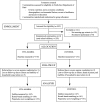Fortified Snack Reduced Anemia in Rural School-Aged Children of Haiti: A Cluster-Randomized, Controlled Trial
- PMID: 28005920
- PMCID: PMC5179061
- DOI: 10.1371/journal.pone.0168121
Fortified Snack Reduced Anemia in Rural School-Aged Children of Haiti: A Cluster-Randomized, Controlled Trial
Abstract
Background: Nutrition in the school-aged child matters for brain development and public policy investments globally. Our group previously conducted a trial in urban schools of Haiti to examine the effects of a fortified peanut butter snack, Vita Mamba, with limited findings for anemia.
Objective: We aimed to test the hypothesis that Vita Mamba, with systematic deworming in both study arms, would significantly reduce anemia among rural, school-aged children.
Methods: A cluster, randomized longitudinal study was conducted in two rural communities of the North-East Department of Haiti, 2014-2015. Healthy children ages 3-16 years were enrolled (n = 321) and assigned by school to intervention (Vita Mamba and deworming) and control (deworming). Vita Mamba contains 260 kcal and meets >75% of the Recommended Dietary Allowance for critical micronutrients. Multivariate regression analyses including propensity score matching techniques to correct for potential group imbalance (Kernel-based Matching and Propensity Score Weighting) were applied to examine difference-in-difference intervention effects.
Results: At baseline, 51% of the children were anemic with no significant differences between study groups. Vita Mamba supplementation showed a consistent, positive effect across regression models on increasing Hb concentration and reducing the odds of anemia compared to the control group after adjusting for child age, vitamin A supplementation, milk consumption, and height-for-age z score. The average treatment effect for the treated in the Propensity Score Weighting models was 0.62±0.27 grams per 100 milliliters (g/dL) for Hb concentration (F = 4.64, P = 0.001), and the odds of anemia were reduced by 88% (Wald χ² = 9.77, P = 0.02). No differences in change in anthropometric markers were evident.
Conclusions: School feeding programs that integrate fortified foods with deworming could reduce anemia burden with important implications for learning, health, and well-being. The rural-urban differences in anemia require further study.
Conflict of interest statement
The authors have declared that no competing interests exist.
Figures

References
-
- Lentz EC, Passarelli S, Barrett CB. The timeliness and cost-effectiveness of the local and regional procurement of food aid. World Dev. 2013;49:9–18.
Publication types
MeSH terms
Substances
LinkOut - more resources
Full Text Sources
Other Literature Sources
Medical

